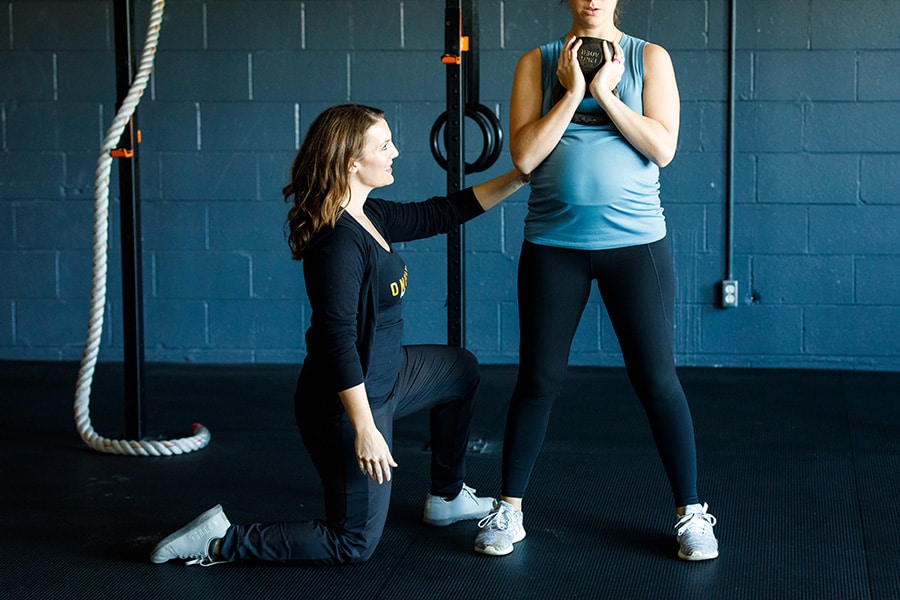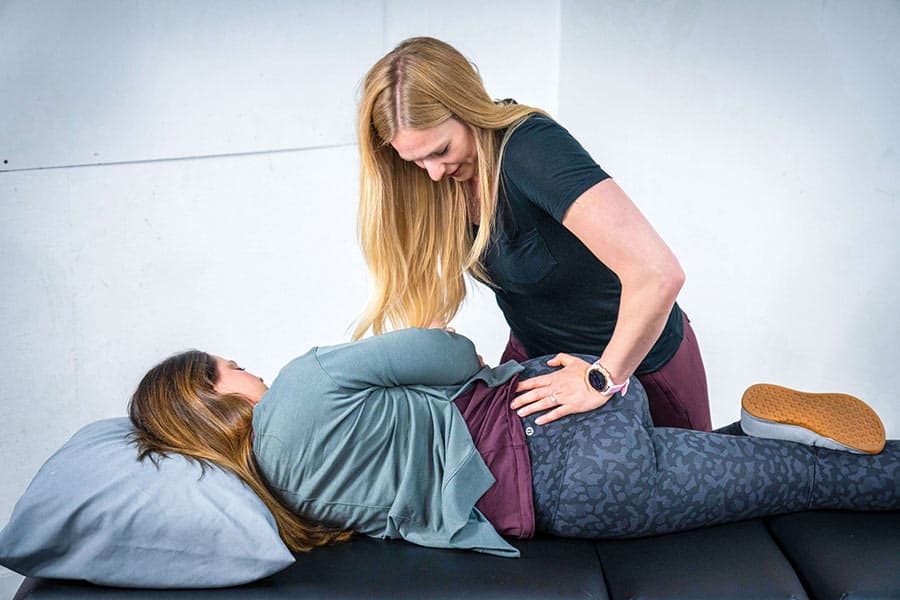
Congratulations! You are pregnant, growing a tiny human that you can soon share with the world. And while many may make it seem like sunshine and rainbows, the reality is that your body is going through some pretty massive changes that affect how you feel and function. For many women, those changes come with pain. In this article, we will outline the most common causes of pain during pregnancy.
Body Changes During Pregnancy
Some of these changes include increased stress on the pelvic floor as the baby grows, increases in body mass, a progressive stretch of the abdominals, changes in the center of gravity, widening of the pelvis, and increased stress on muscles around the hips and core. Your hormones are changing and with that, your mood and stress can be drastically different than pre-baby, you are retaining more fluid, and your appetite is changing. That’s a lot to manage!
With all of these changes, virtually all pregnant women experience some musculoskeletal pain during pregnancy (pelvic pain, back pain, hip pain, etc). 1 in 4 women reports pain is so severe it is debilitating! However, often this pain is dismissed by medical providers and others as part of the process.
Are you tired of being told “that’s just part of being pregnant?” or “don’t worry that pain will go away once you give birth”. Us too.
At Onward we specialize in treating pregnancy-related pain and in helping women stay as comfortable as possible through their pregnancy. We want you to know that help is available! You don’t have to live with pain, there is a lot we can do during pregnancy to help minimize your discomfort.
Let’s break down the top 5 most common causes of pain during pregnancy and then get into what you can do about it.
5 most common causes of pain during pregnancy
1. Low Back Pain
Low back pain affects 50-80% of women during their pregnancy. The mechanical, hormonal, and vascular changes your body is going through can contribute to this. Factors that may increase your risk of dealing with back pain during pregnancy include increased weight during pregnancy, previous history of low back pain, low job satisfaction, and a sedentary lifestyle. The great news is that women who participate in education and strengthening programs during early pregnancy can avoid problems from low back pain! There is still a lot you can do in later pregnancy as well. Don’t let the fact that low back pain is common during pregnancy to stop you from seeking help.
2. Pelvic Girdle Pain
This refers to pain in the buttocks/sacrum area that can also be felt in the front between hips (pubic symphysis). During your pregnancy, the baby grows from the size of a poppy seed to the size of a watermelon! That is a lot of pressure for the pelvic muscles to tolerate. Up to 50% of women deal with pelvic girdle pain before 20 weeks of their pregnancy and 60-70% experience this pain in later pregnancy. The good news is that exercise, manual therapy, and supportive belts can all help.
3. Lower Abdominal/Round Ligament Pain
The round ligaments connect the uterus to the pelvis. As the baby grows these ligaments stretch which sometimes can result in pain. This pain can be achy or sharp and is felt in the abdomen near the hips. It can last seconds to hours and is often felt more with quick movements.
4. Muscle pain and cramping
As many as 75% of women will experience muscle cramping during pregnancy. Most commonly this is felt at night in the legs and during the third trimester. This is often described as “a strong, painful contraction or tightening of a muscle in the thigh, the calf or the foot that comes on suddenly and lasts from a few seconds to several minutes.” Possible contributing factors include postural and hormonal fluctuations, weight gain, and fluid retention.
5. Wrist Pain/Carpal Tunnel
Wrist pain is seen in up to 60% of women during pregnancy. The incidence of CTS in pregnant women is two to three times higher than in women who are not pregnant. Symptoms can include tingling, numbness, weakness, or pain in the fingers or hands. Hormonal changes and increased swelling are proposed to be contributing factors.
How to Reduce Pain During Pregnancy?
Manual Techniques
When you come in to see us at Onward we do a thorough examination to determine the factors contributing to your pain. We can then use a variety of manual techniques to help bring down the pain level, always following it up with specific movements or exercises. This might include some soft tissue massage to help calm down that lower back pain or maybe some upper back mobilization to help with the tightness between your shoulder blades. It will always be specific to you and your individual needs.
Exercise
Exercise is key not only throughout pregnancy but in the postpartum period as well. Exercise is shown to help decrease pregnancy-related pain, help maintain healthy weight gain, improve or maintain fitness, decrease gestational hypertension, shorten labor, and reduce the risk of cesarean section.
So what exercises would we do? All of the exercise! But seriously, a combination of different forms of activity, specific exercises you enjoy participating in can help decrease pain and maintain your health and the health of your baby. At Onward we LOVE helping women continue to exercise throughout their pregnancy. We are experts in modifying workouts for different stages of your pregnancy and prescribing specific exercises to improve your pain.
Stress Reduction Techniques
Setting aside the time to meditate or do some deep breathing can be really helpful in calming your system down and making pain levels feel more manageable. You have a lot on your plate, making time to prioritize your needs and mental health is very important.
You are Not Alone – Pain During Pregnancy is NORMAL
You do not have to figure out how to manage it all on your own! If you are struggling with pregnancy-related pain, know that help is available. Click here to schedule with one of our doctors of physical therapy that specialize in working with women through pregnancy.
Not sure if we can help? We offer free 15-minute phone consultations at our locations to make sure it feels like the right fit. Did you know we also offer virtual appointments? If there isn’t an Onward within driving distance we may still be able to help. Send us an email and we will help get you connected with the care you deserve.
Resources:
- Bergström, C., Persson, M., Nergård, K.-A., & Mogren, I. (2017). Prevalence and predictors of persistent pelvic girdle pain 12 years postpartum. BMC Musculoskeletal Disorders, 18(1). doi:10.1186/s12891-017-1760-5
- Clinton, Susan C. PT, DScPT, OCS, WCS, FAAOMPT1; Newell, Alaina PT, DPT, WCS, CLT-LANA2; Downey, Patricia A. PT, PhD, DPT3; Ferreira, Kimberly PT, PhD, MSPT4 Pelvic Girdle Pain in the Antepartum Population: Physical Therapy Clinical Practice Guidelines Linked to the International Classification of Functioning, Disability, and Health From the Section on Women’s Health and the Orthopaedic Section of the American Physical Therapy Association, Journal of Women’s Health Physical Therapy: May 2017 – Volume 41 – Issue 2 – p 102-125
doi: 10.1097/JWH.0000000000000081 - Gregg, V. H., & Ferguson, J. E. (2017). Exercise in Pregnancy. Clinics in Sports Medicine, 36(4), 741–752. doi:10.1016/j.csm.2017.05.005
Kesikburun, S., Güzelküçük, Ü., Fidan, U., Demir, Y., Ergün, A., & Tan, A. K. (2018). Musculoskeletal pain and symptoms in pregnancy: a descriptive study. Therapeutic Advances in Musculoskeletal Disease, 10(12), 229–234. doi:10.1177/1759720×18812449 - Kiil, R. M., Arnbak, B. A.-M., Zejden, A., Schiøttz-Christensen, B., Hendricks, O., & Jurik, A. G. (2021). Pregnancy-related sacroiliac joint findings in females with low back pain: a four-year magnetic resonance imaging follow-up study. Acta Radiologica, 028418512110171. doi:10.1177/02841851211017108
- Liddle, S. D., & Pennick, V. (2015). Interventions for preventing and treating low-back and pelvic pain during pregnancy. Cochrane Database of Systematic Reviews. doi:10.1002/14651858.cd001139.pub
- Shah S, Banh ET, Koury K, Bhatia G, Nandi R, Gulur P. Pain Management in Pregnancy: Multimodal Approaches. Pain Res Treat. 2015;2015:987483. doi:10.1155/2015/987483
Recent Articles
Why Early Intervention Physical Therapy Accelerates Your Recovery

What to Expect at Your First Physical Therapy Session?

How to Choose a Physical Therapist

The Top 5 Misconceptions About Physical Therapy

The Complete Guide to Physical Therapy





